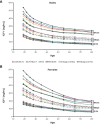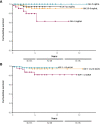Interpreting growth hormone and IGF-I results using modern assays and reference ranges for the monitoring of treatment effectiveness in acromegaly
- PMID: 38027199
- PMCID: PMC10656675
- DOI: 10.3389/fendo.2023.1266339
Interpreting growth hormone and IGF-I results using modern assays and reference ranges for the monitoring of treatment effectiveness in acromegaly
Abstract
Standard treatment for acromegaly focuses on the achievement of target absolute levels of growth hormone (GH) and insulin-like growth factor (IGF-I). The appropriateness of these targets when measured using modern assay methods is not well defined. This paper reviews biochemical status assessed using methods available at the time and associated clinical outcomes. GH measurements were shown to provide an indication of changes in tumor size, and failure of GH suppression after glucose stimulation is associated with tumor recurrence. IGF-I levels were more closely associated with changes in symptoms and signs. Reduced GH and IGF-I concentrations were shown to be associated with increased longevity, although the degree of increase has only been analyzed for GH. Lowering of GH and IGF-I has consistently been associated with improved outcomes; however, absolute levels reported in previous studies were based on results from methods and reference ranges that are now obsolete. Applying previously described absolute thresholds as targets (e.g. "normal" IGF-I level) when using current methods is best applied to those with active acromegaly symptoms who could benefit from further lowering of biochemical markers. In asymptomatic individuals with mild IGF-I or GH elevations, targeting biochemical "normalization" would result in the need for combination pharmacotherapy in many patients without proven benefit. Measurement of both GH and IGF-I remains an essential component of diagnosis and monitoring the effectiveness of treatment in acromegaly; however, treatment goals based only on previously identified absolute thresholds are not appropriate without taking into account the assay and reference ranges being employed. Treatment goals should be individualized considering biochemical improvement from an untreated baseline, symptoms of disease, risks, burdens and costs of complex treatment regimens, comorbidities, and quality of life.
Keywords: IGF-I; acromegaly; biochemical markers; growth hormone; therapy; treatment response.
Copyright © 2023 Clemmons and Bidlingmaier.
Conflict of interest statement
DC is a consultant for Amolyt, Crinetics Pharmaceuticals, Inc., and Novo Nordisk. MB reports receiving research support, consultancy, and/or lecture fees from Camurus, Chiasma, Crinetics Pharmaceuticals, Inc., Diasorin, Genexine, Genescience, IDS, Ionis, IPSEN, Merck, Midatech, Novartis, Ono, OPKO, Pfizer, Recordati, Roche, Sandoz, and StrongBridge. The authors declare that this study received funding from Crinetics Pharmaceuticals, Inc. The funder had the following involvement with the study: reviewed the manuscript for scientific accuracy and rigor, and provided funding for technical editorial support of the manuscript.
Figures




Similar articles
-
Assessment of disease activity in treated acromegalic patients using a sensitive GH assay: should we achieve strict normal GH levels for a biochemical cure?J Clin Endocrinol Metab. 2002 Jul;87(7):3142-7. doi: 10.1210/jcem.87.7.8631. J Clin Endocrinol Metab. 2002. PMID: 12107214
-
Role of insulin-like growth factor-I in diagnosis and management of acromegaly.Endocr Pract. 2004 Jul-Aug;10(4):362-71. doi: 10.4158/EP.10.4.362. Endocr Pract. 2004. PMID: 15760781 Review.
-
Evaluation of disease status with sensitive measures of growth hormone secretion in 60 postoperative patients with acromegaly.J Clin Endocrinol Metab. 1998 Nov;83(11):3808-16. doi: 10.1210/jcem.83.11.5266. J Clin Endocrinol Metab. 1998. PMID: 9814451
-
Current concepts in the biochemical assessment of the patient with acromegaly.Growth Horm IGF Res. 2003 Aug;13(4):171-84. doi: 10.1016/s1096-6374(03)00029-7. Growth Horm IGF Res. 2003. PMID: 12914750 Review.
-
Dynamic tests and basal values for defining active acromegaly.Neuroendocrinology. 2006;83(3-4):200-4. doi: 10.1159/000095528. Epub 2006 Oct 13. Neuroendocrinology. 2006. PMID: 17047383 Review.
Cited by
-
The changing landscape of acromegaly - an epidemiological perspective.Rev Endocr Metab Disord. 2024 Aug;25(4):691-705. doi: 10.1007/s11154-024-09875-z. Epub 2024 Feb 10. Rev Endocr Metab Disord. 2024. PMID: 38337125 Review.
-
Biochemical Control in a Colombian Cohort of Patients With Acromegaly: A 12-Month Follow-Up Study (2017-2023).Cureus. 2024 Dec 11;16(12):e75553. doi: 10.7759/cureus.75553. eCollection 2024 Dec. Cureus. 2024. PMID: 39803157 Free PMC article.
-
Acromegaly: diagnostic challenges and individualized treatment.Expert Rev Endocrinol Metab. 2025 Jan;20(1):63-85. doi: 10.1080/17446651.2024.2448784. Epub 2025 Jan 5. Expert Rev Endocrinol Metab. 2025. PMID: 39757391 Review.
-
Pitfalls in the lab assessment of hypopituitarism.Rev Endocr Metab Disord. 2024 Jun;25(3):457-465. doi: 10.1007/s11154-024-09881-1. Epub 2024 Apr 13. Rev Endocr Metab Disord. 2024. PMID: 38609701 Free PMC article. Review.
-
Digital Voice Analysis as a Biomarker of Acromegaly.J Clin Endocrinol Metab. 2025 Mar 17;110(4):983-990. doi: 10.1210/clinem/dgae689. J Clin Endocrinol Metab. 2025. PMID: 39363748 Free PMC article.
References
Publication types
MeSH terms
Substances
LinkOut - more resources
Full Text Sources

